13 Implementing mechanisms
We now reach the “spicy” part of the development of PondTrade. Until this point, settlements are completely static, and traders are only created in setup, then travel back and forth without any consequence to settlements.
First, we want to implement the feedback loop described in the conceptual model, connecting settlement size, production, and trade inflow.
Let us re-organise the behavioural cycle of traders into a new separate procedure update-traders:
to update-traders
let tradersInBase traders with [is-in-base]
let tradersInDestination traders with [is-in-destination]
; UPDATE LAST POSITION
ask traders
[
; update lastPosition if in a patch center
if ((xcor = [pxcor] of patch-here) and (ycor = [pycor] of patch-here))
[
set lastPosition patch-here
]
]
; UNLOAD
ask (turtle-set tradersInBase tradersInDestination) with [cargoValue > 0]
[
; unload cargo (changes sizeLevel)
unload-cargo
; load cargo (changes stock)
load-cargo
]
; CHOOSE DESTINATION
ask tradersInBase
[
; update the destination whenever in the base settlement and there is cargo to transport
choose-destination
]
; FIND DIRECTION in route
ask (turtle-set tradersInBase tradersInDestination)
[
find-direction
]
; MOVE towards the next position in the route
ask traders
[
; move following the route when there is cargo to transport
move-to-destination
]
end
to choose-destination ; ego = trader
let thisTrader self
; get routes connecting the base settlement
let routesFromBase get-routes-to-settlement [base] of thisTrader
; order these routes by benefit/cost ratio
set routesFromBase sort-by [ [?1 ?2] -> benefit-cost-of-route ?1 > benefit-cost-of-route ?2 ] routesFromBase
; print the options available
; foreach routesFromBase
; [
; print "==============================================================="
; print "route between:"
; print [who] of get-origin-and-destination ?
; print "has the benefit-cost ratio of:"
; print benefit-cost-of-route ?
; ]
; print "-x-x-x-x-x-x-x-x-x-x-x-x-x-x-x-x-x-x-x-x-x-x"
; select the one with higher benefit/cost ratio
set route first routesFromBase
; get the settlement of destination
set destination one-of (get-origin-and-destination route) with [who != [who] of ([base] of thisTrader)]
end
to find-direction ; ego = trader
; find where in the route list is the trader
let currentPosition position lastPosition route
; set direction if in a settlement
ifelse (currentPosition = 0) ; in the first extreme of the route list
[
; move in the route list towards larger index numbers
set direction 1
]
[
if (currentPosition = (length route - 1)) ; in the last extreme of the route list
[
; move in the route list towards smaller index numbers
set direction -1
]
]
; else the trader is in route to either the base or the destination
end
to move-to-destination ; ego = trader
; find where in the route list is the trader
let currentPosition position lastPosition route
; move through the route following direction
let targetPatch item (currentPosition + direction) route
;move-to targetPatch ; constant travel time (1 patch per tick)
facexy ([pxcor] of targetPatch) ([pycor] of targetPatch)
forward min (
list
(1 / [pathCost] of patch-here) ; the maximum distance in a tick in the current patch
(distancexy ([pxcor] of targetPatch) ([pycor] of targetPatch)) ; the distance to the target patch
)
end
to-report is-in-base ; ego = trader
report (xcor = [xcor] of base) and (ycor = [ycor] of base) ; if the trader arrived at the center of the base patch
end
to-report is-in-destination ; ego = trader
report (xcor = [xcor] of destination) and (ycor = [ycor] of destination) ; if the trader arrived at the center of the destination patch
endNotice that we refactor the previous code, splitting the former procedures into several more specialised parts.
We then define the new procedures to handle the interaction between traders and settlements:
traders-own [ base route destination direction lastPosition cargoValue ]
...
to unload-cargo ; ego = trader
let thisTrader self
let settlementHere one-of settlements-here
; unload cargo
ask settlementHere [ add-trade-effect [cargoValue] of thisTrader ]
end
to load-cargo ; ego = trader
let settlementHere one-of settlements-here
; load cargo
set cargoValue [sizeLevel] of settlementHere
end
to add-trade-effect [ value ] ; ego = settlement
set sizeLevel sizeLevel + value
end
Observe that we are defining a very simple “submodel” , where the economic size units of one settlement produce an equivalent amount of transportable value (cargoValue), which is transferred by traders to another settlement, again as economic size units. However, with this mechanism, we are increasing the economic size of settlements in every trader trip but never decrease it. To avoid this, we must specify a second mechanism that “decays” economic size with time, up to a baseline arbitrary value (i.e., 1).
For now, we implement this mechanism directly inside the goprocedure, where we also call update-traders:
to go
tick
update-traders
; the size of settlements decays with a constant rate, up to 1 (minimum)
ask settlements
[
set sizeLevel max (list 1 (sizeLevel * (1 - (settlementSizeDecayRate / 100)) ) )
]
update-display
endWe must add to the interface yet another parameter to regulate decay, settlementSizeDecayRate (from 0 to 25, by 0.01, default value of 5). This is expressed as the percentage of sizeLevel that is subtracted at each simulation step.
To better explore the effects of this feedback loop, it is time for us to start adding some plots to the interface. Select Plot in the dropdown menu and add two plot objects, as you have done with buttons, sliders, etc. Configure them as follows:
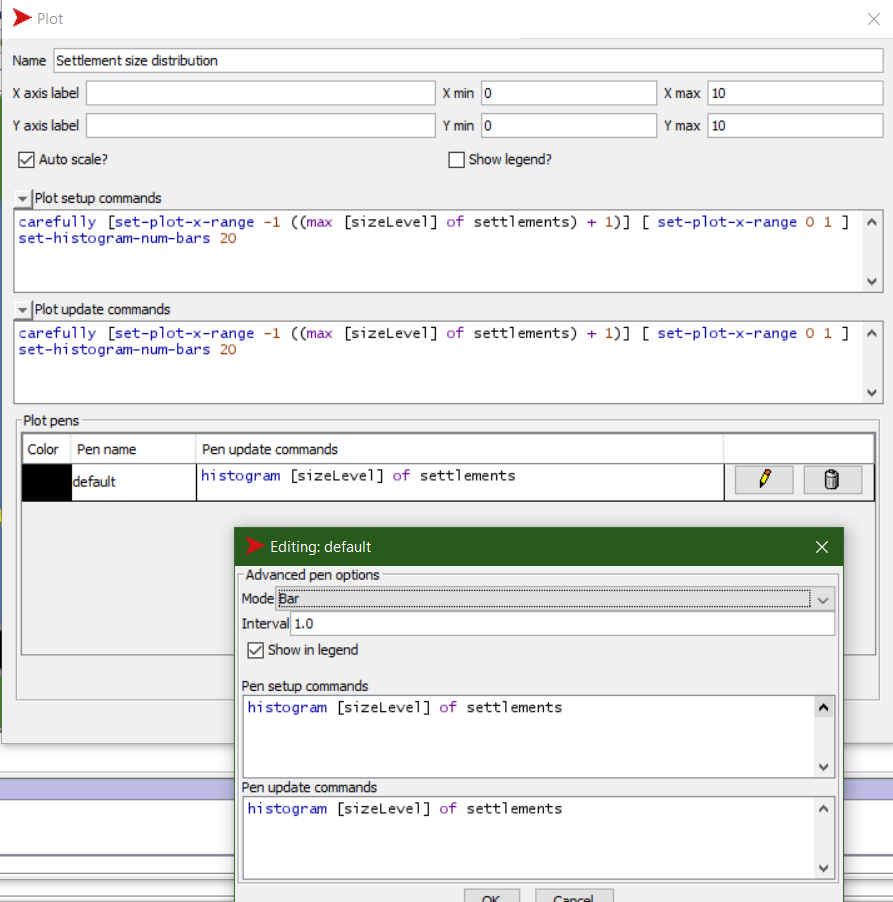 |
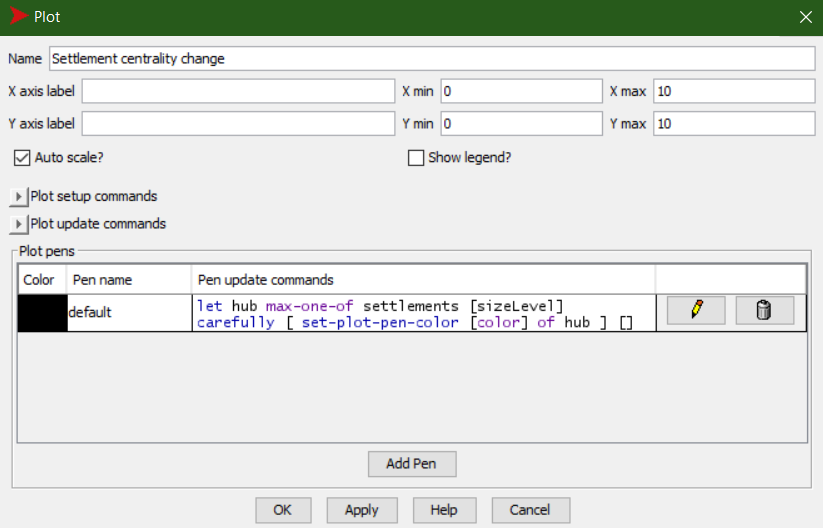 |
We can now run the model with a few settlements and repeat go many times. Explore different seed numbers. Are settlements reacting to traders’ dynamics at all? Is the value of settlementSizeDecayRate too high or low? What are we doing wrong?
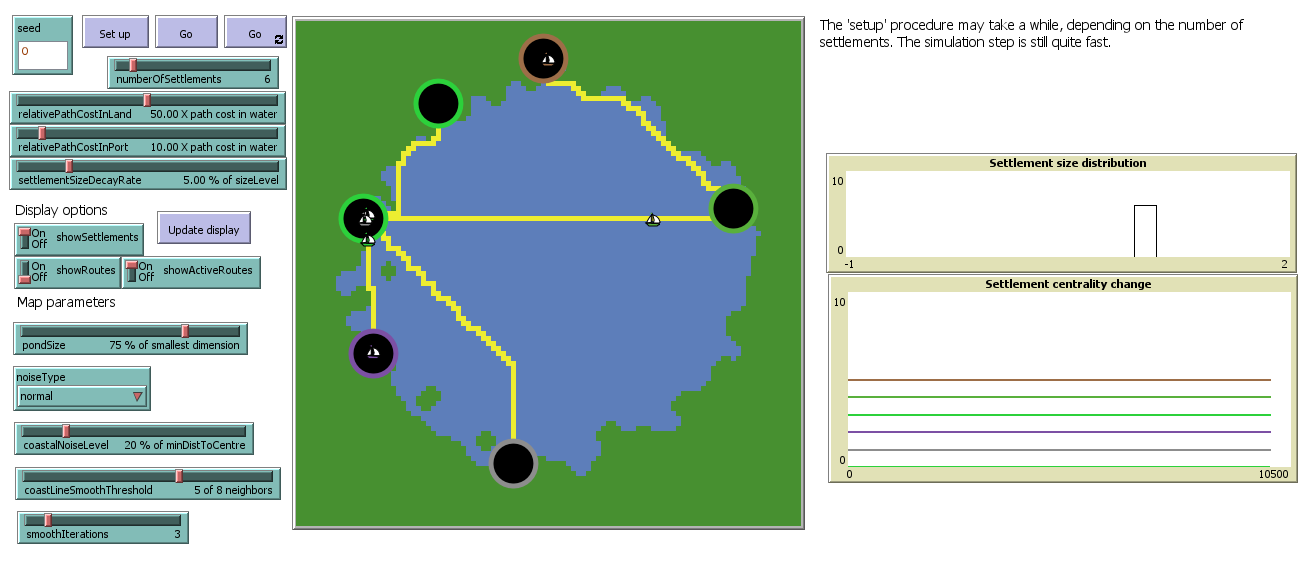
Pond Trade step 8
Before moving to the second feedback loop, we must solve our problem. If you followed any of the different approaches for debugging (e.g., inspecting agents, printing messages in mid-code), you have detected that traders are not transporting any cargoValue. The problem resides in how we have scheduled the calls for unload-cargoand load-cargo. Notice that we added load-cargo to a conditional call ask (turtle-set tradersInBase tradersInDestination) with [cargoValue > 0], only relevant to traders with cargo, which is impossible for traders to fulfill initially.
We re-organise update-tradersas follows:
to update-traders
...
; UNLOAD
ask (turtle-set tradersInBase tradersInDestination) with [cargoValue > 0]
[
; unload cargo (changes sizeLevel)
unload-cargo
]
; LOAD
ask (turtle-set tradersInBase tradersInDestination)
[
; load cargo (changes stock)
load-cargo
]
...
end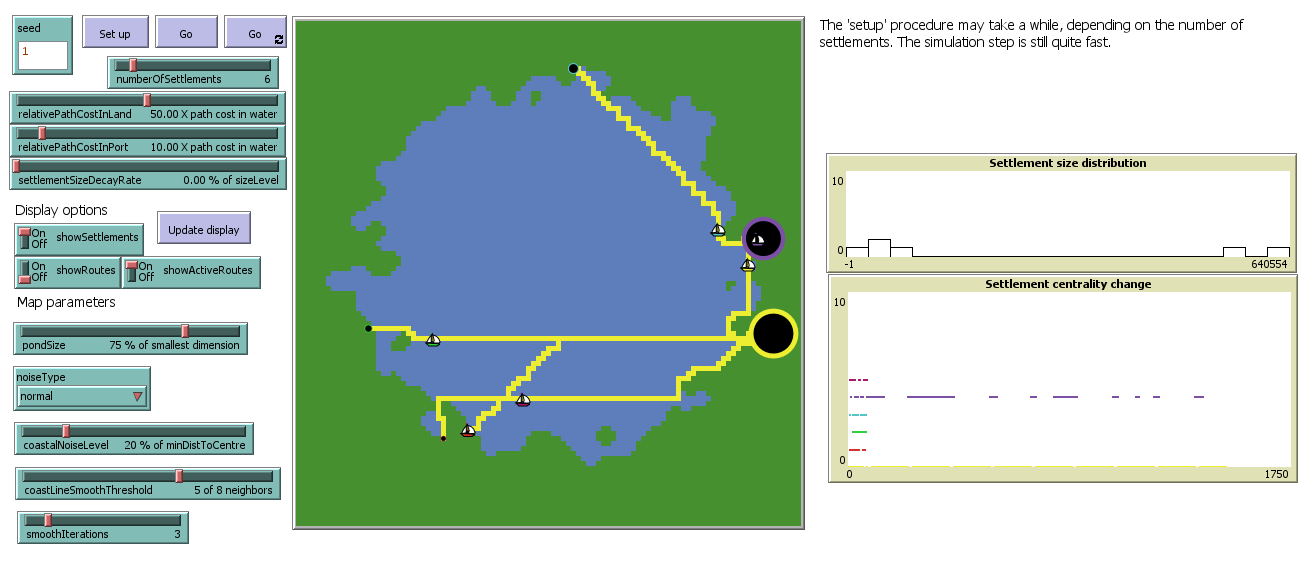
Pond Trade step 8 (after correction)
We can now see how, quite often, one or very few hubs emerge among settlements.
The second positive feedback loop in our concept model relates settlement size, the number of traders per settlement, and trade inflow.
The key addition is that now we will have to differentiate, for each settlement, between currentNumberOfTraders and potentialNumberOfTraders, and update these according sizeLevel. To wrap up all this, we finally implement an update procedure specifically for settlements (update-settlements).
We will also need to manage the traders that are left outside the maximum value for its base settlement. We create the tag isActivated, in order to avoid creating and deleting too many traders in the same simulation run (i.e., it might become a problem when who numbers start getting bigger and bigger).
settlements-own
[
sizeLevel
currentNumberOfTraders potentialNumberOfTraders
]
traders-own
[
isActivated
base route destination direction lastPosition
cargoValue
]
...
to create-traders-per-settlement
ask settlements
[
let thisSettlement self ; to avoid the confusion of nested agent queries
set potentialNumberOfTraders get-potential-number-of-traders
hatch-traders potentialNumberOfTraders ; use the sizeLevel variable as the number of traders based in the settlement
[
setup-trader thisSettlement
]
set currentNumberOfTraders get-current-number-of-traders
]
end
to setup-trader [ baseSettlement ]
set base baseSettlement
set isActivated true
; give meaningful display related to base
set shape "sailboat side" ; import this shape from the library (Tools > Shape editor > import from library)
set color [color] of base
set size 3
choose-destination
end
...
to update-settlements
ask settlements
[
let thisSettlement self
; the sizeLevel of settlements decays with a constant rate, up to 1 (minimum)
set sizeLevel max (list 1 (sizeLevel * (1 - (settlementSizeDecayRate / 100)) ) )
; determine the current and potential number of traders
set currentNumberOfTraders get-current-number-of-traders
set potentialNumberOfTraders get-potential-number-of-traders
; conditions favors the creation of new traders
if (random-float 1 > currentNumberOfTraders / potentialNumberOfTraders )
[
; create a new trader or activate an old one
repeat 1
[
ifelse (any? traders with [not isActivated])
[
ask one-of traders with [not isActivated]
[
setup-trader thisSettlement
move-to thisSettlement
]
]
[
hatch-traders 1
[
setup-trader thisSettlement
]
]
]
set currentNumberOfTraders get-current-number-of-traders ; update currentNumberOfTraders
]
]
end
...
to-report get-potential-number-of-traders ; ego = settlement
report (
1 +
(sizeLevel - 1)
)
end
to-report get-current-number-of-traders ; ego = settlement
let thisSettlement self
report count traders with [isActivated and base = thisSettlement ]
end
Settlements will now calculate potentialNumberOfTraders at every simulation step as a number equal to its size and be allowed to create/reactivate or deactivate any traders accordingly.
Add a new Plot to visualise the count of traders through time, using the update command: plot count traders with [isActivated]
Our second feedback loop is now up and running!
However, our implementation is still rough on the edges and needs a bit of refactoring and model extensions.
The representation of the production process is overly simplistic. With no separable entity from sizeLevel, production value gets immediately replaced after traders load their cargo. We must introduce a new settlement variable, stock, to keep track of the flow of economic value and implement a more explicit representation of production and value decay, independent of size decay. For this, we introduce two new parameters, productionRate and stockDecayRate (use same interface configuration from settlementSizeDecayRate).
settlements-own
[
...
stock
]
...
to create-coastal-settlements
; consider only coastal patches
let coastalPatches patches with [(isLand = true) and (any? neighbors with [isLand = false])]
repeat numberOfSettlements
[
; ask a random coastal patch without a settlement already
ask one-of coastalPatches with [not any? settlements-here]
[
sprout-settlements 1 ; creates one "turtle" of breed settlements
[
set sizeLevel 1 ; the size level is initiated at minimum (i.e., 1)
set stock 0
set shape "circle 2"
]
; replace the land path cost with the port pathCost
set pathCost relativePathCostInPort
; exclude this patch from the pool of coastal patches
set coastalPatches other coastalPatches
]
]
end
...
to load-cargo ; ego = trader
let settlementHere one-of settlements-here
; load cargo
set cargoValue [stock] of settlementHere
ask settlementHere [ set stock 0 ] ; empty the settlement stock
end
...
to update-settlements
ask settlements
[
let thisSettlement self
; the sizeLevel of settlements decays with a constant rate, up to 1 (minimum)
set sizeLevel max (list 1 (sizeLevel * (1 - (settlementSizeDecayRate / 100)) ) )
; production in stock also decays with a constant rate
set stock stock * (1 - (stockDecayRate / 100))
; prodution is generated in proportion to sizeLevel, following a constant rate
set stock stock + sizeLevel * (productionRate / 100)
; determine the current and potential number of traders
set currentNumberOfTraders get-current-number-of-traders
set potentialNumberOfTraders get-potential-number-of-traders
; conditions favors the creation of new traders
if (random-float 1 > currentNumberOfTraders / potentialNumberOfTraders )
[
; create a new trader or activate an old one
repeat 1
[
ifelse (any? traders with [not isActivated])
[
ask one-of traders with [not isActivated]
[
setup-trader thisSettlement
move-to thisSettlement
]
]
[
hatch-traders 1
[
setup-trader thisSettlement
]
]
]
set currentNumberOfTraders get-current-number-of-traders ; update currentNumberOfTraders
]
]
endIn get-potential-number-of-traders, there is a hidden magic number worth exploring. We name it frequencyOverQualityand make it a “trait” of settlements, setting it in create-coastal-settlements as a random number between 0 and 1:
settlements-own
[
...
frequencyOverQuality
]
...
to create-coastal-settlements
; consider only coastal patches
let coastalPatches patches with [(isLand = true) and (any? neighbors with [isLand = false])]
repeat numberOfSettlements
[
; ask a random coastal patch without a settlement already
ask one-of coastalPatches with [not any? settlements-here]
[
sprout-settlements 1 ; creates one "turtle" of breed settlements
[
set sizeLevel 1 ; the size level is initiated at minimum (i.e., 1)
set stock 0
set frequencyOverQuality random-float 1
set shape "circle 2"
]
; replace the land path cost with the port pathCost
set pathCost relativePathCostInPort
; exclude this patch from the pool of coastal patches
set coastalPatches other coastalPatches
]
]
end
to-report get-potential-number-of-traders ; ego = settlement
report (
1 +
(sizeLevel - 1) * frequencyOverQuality
)
endAs its name tries to state, this trait’s meaning is: “how much the frequency of trade is prioritised over the quality of the cargo”. This is because the more traders a settlement has, the less cargo each will be able to get from stock, which will have less time to recover. Therefore, this trait represents an interesting aspect of how different settlements could organise trade.
We can now observe how the number of traders in our pond reaches an oscillating, stable low level most of the time. We can observe some exceptions by exploring higher values of numberOfSettlements. With enough settlements, our feedback loops push the dynamics towards the emergence of hubs, boosting the overall number of traders.
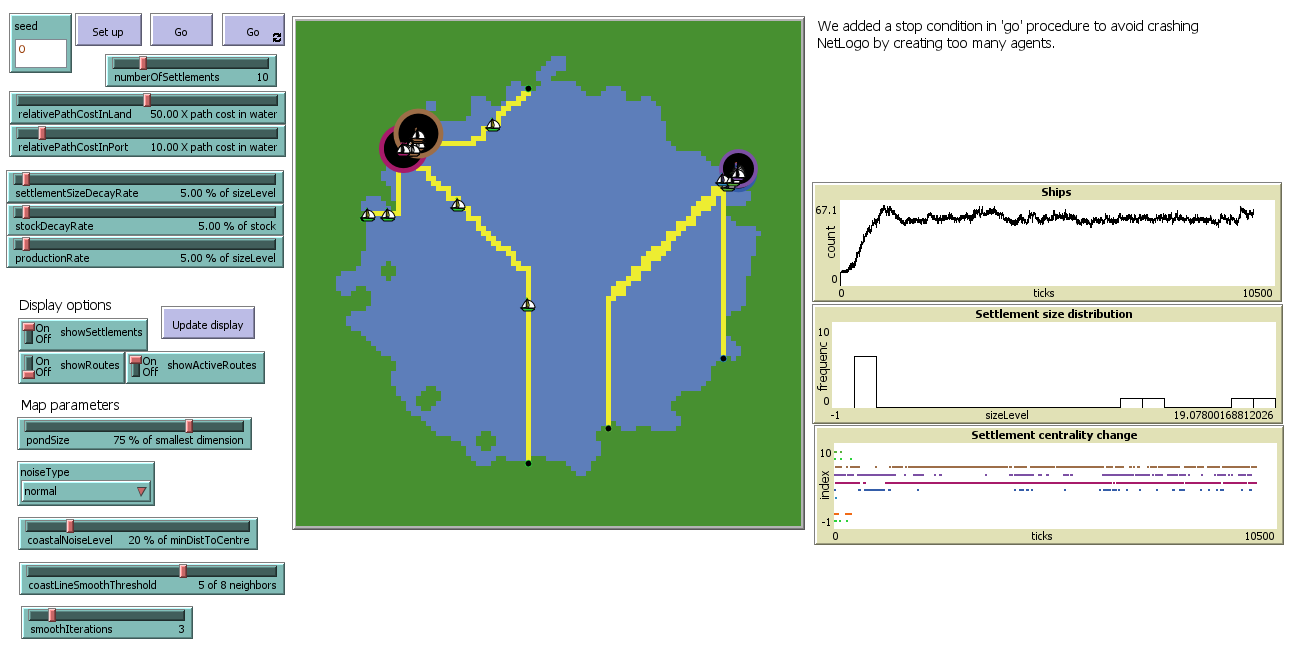
Pond Trade step 9
We reach the end of the implementation steps for the first-tier PondTrade model. Given all changes and extensions we made, we must go back to our conceptual model and update it accordingly.

Pond Trade conceptual model revised at step 9 (first tier)
This graphical description is still far from the implementation code, as it should be. However, it is now adequate for the new conceptual changes we introduced in code.